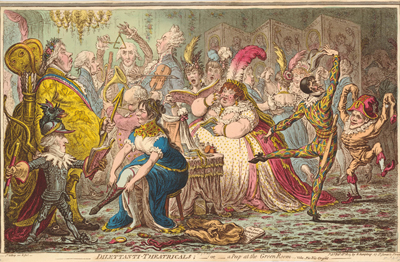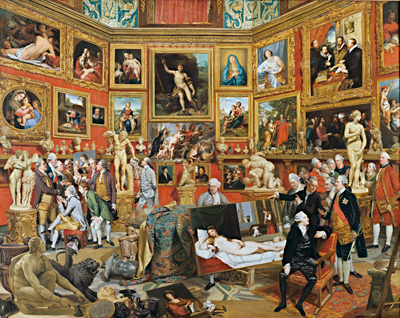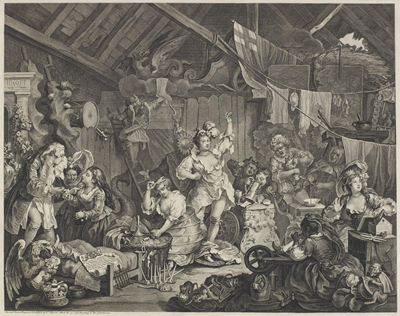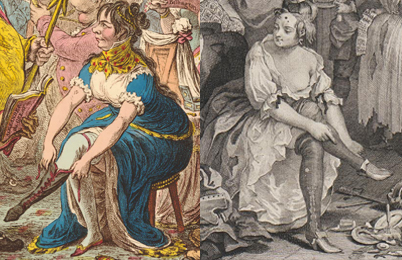Dilettanti-Theatricals, or a Peep at the Green Room
This is the third and most brilliant of the prints Gillray devoted to the controversial Pic Nic Society (aka Dilettanti). The other two were Blowing up the Pic Nic's, or Harlequin Quixotte attacking the Puppets (April 1, 1802) and The Pic-Nic Orchestra (April 23, 1802).
Beginning in the Spring of 1802, the largely aristocratic Pic Nic Society aroused the ire of the professionals of the patent theaters (e.g. Covent Garden and Drury Lane) by staging musical and dramatic performances at a "private" theatre in Tottenham Street funded by the subscription of its members. This print purports to show some of the more prominent members of the Pic Nics as they prepare for the evening's entertainment. Judging from the music score and prompt books in the hands of the performers, the bill of fare includes some "bravura airs" sung by a pair of female vocalists, and at least some scenes from Nathaniel Lee's Tragedy The Rival Queens; or the Death of Alexander the Great.

© Trustees of the British Museum
Like Gillray's earlier Pic-Nic Orchestra, Dilettanti Theatricals is a parody of what was known in serious art circles as a "conversation piece." A conversation piece typically consisted of portraits of identifiable individuals in a variety of usually significant poses, engaged in a common activity. One of the most famous is Johan Zoffany's Tribune of the Uffizi, which contains a veritable who's who of the British art collector's world gazing at and conversing about art.

© Royal Collection Trust, Windsor Castle
In Gillray's case, the common activity of preparing for the evening's performances provides him with an opportunity to do what he does best—create wonderfully ironic or satiric portraits of many of the most conspicuous and fashionable members of the theatre-loving aristocracy. But, as we will see, it also allows him to mount a cumulative attack on the entire enterprise of the Pic Nics. We can begin at the individual level.
On the far left, for instance, there is the utter incongruity of the tiny and sweet-faced Lord Mount Edgcumbe, wearing armor with a gorgon's head and a helmet with a fire-breathing dragon, studying the part of Alexander the Great. The discrepancy of size is further emphasized by his juxtaposition with the enormous Lord Cholmondeley.
There is a similar, but reverse, incongruity with the huge Lord Cholmondeley playing Cupid, usually pictured as a small putti. But in this case his golden suit decorated with images of torches, hearts, and love-birds, his sash inscribed with "Amor Vincit Omnia" (Love Conquers All), his wings which resemble the forlorn faces of women, and his clearly phallic gold arrow—all reflect his reputation as a relentless sexual predator with a long list of unfortunate conquests.
In the center of the print gazing at the mirror on her dressing table, and applying beauty patches to her face, is the enormous (and enormously vain, Gillray would suggest) Countess of Buckinghamshire. Her performance is apparently being fueled by the spirits (labeled Usquebaugh) at the foot of her dressing table. But the book in her hand suggests yet another incongruity in the making because it indicates that she is playing Roxana, the wife of Alexander the Great, opposite the tiny Lord Mount Edgcumbe.
The orchestra consists of Lord Carlisle on the bassoon, Lord Abercorn on the triangle, and Lord Salisbury (awkwardly) playing the violin. All of them would have been subject to the outrage voiced by The Morning Post (April 17, 1802) in response to the report of Lord Cholmondeley playing the flute in another Pic Nic production, that "one of our hereditary legislators" would so far "forget what is due to his character, [as to] step into an orchestra before a public-company, paying by subscription for admission." The three are joined by the avid hunter, Lord Derby, playing, of course, a hunting horn.
Next to them, two women are practicing ":Bravura Airs a la Billington." They are identified variously as the Miss Anguishes, the Miss Abrams, or Miss Carpenter and Miss Anguish by the British Museum and other sources. But whoever they are, the point is that they are the Pic-Nic replacements of a professional performance by the famous Mrs Elizabeth Billington, (who appears among the aggrieved professionals in Blowing up the Pic-Nics (April 1, 1802) and in Gillray's portrait caricature of her,. A Bravura Air. Mandane.
On the far right, following recent developments in harlequinade performances, the outlandish Sir Lumley Skeffington appears as Harlequin and the hunchback Lord Kircudbright dances with him as the now obligatory clown.
As is frequently noted, Dilettanti-Theatricals owes a general debt to Hogarth's print of Strolling Actresses in a Barn which shows the travelling performers of another class getting ready for their evening's performances. The luxury and decadence of the green room of the Pic-Nic society with its floral wall and floor coverings, its golden candelabra, and its background screen, are in stark contrast to the squalid quarters of the poor and threadbare acting troupe portrayed by Hogarth.

© Lewis Walpole Library, Yale University
But that's not the only connection between the two prints. The Strolling Actresses depicts the last performance of this troupe before the "Act Against Strolling Players" which in 1737 forbad performances outside London and Westminster without a license. (The Act's title is visible in a note on the crown in the lower left corner.) The Dilettanti Theatricals is similarly part of a controversy about whether private theatricals such as those of the Pic-Nic or Dilettanti Society infringed on the patents of the regular London theatres. Gillray's earlier Blowing Up the Pic-Nics (April 1, 1802) specifically addressed that controversy. But there may be an allusion to it here in Gillray's choice of the play: the Rival Queens. For at least to the managers and staff of the patent theatres, the Dilettanti represented an unwelcome rival with potentially tragic consequences.
But there is yet another possble connection to Hogarth which may suggest Gillray's final verdict on the Pic Nics. The pose of Lady Salisbury lacing her boot may be indebted to Plate 3 of A Rake's Progress where another, very different kind of performer (what today we would call an "exotic dancer") adjusts her stockings before ascending to the stage.

© Lewis Walpole Library, Yale University
But even if this potential allusion is discounted, we still have a Marchioness, the wife of the King's Lord Chamberlain, changing clothes in front of the other performers while staring at the very phallic arrow of a known philanderer; a Countess with so many patches on her face that she begins to look like one of Hogarth's harlots; the Prince of Wales with two women neither of whom is his legal wife, and in the upper right hand corner, only partially screened from view, some obvious extra-curricular activities involving other members of the cast with the notorious lecher, the Duke of Queensbury, and the playboy George Hanger.
The folds of the screen include appropriate images representing the arts performed at the theater, including music (Handel and St. Cecilia) and drama (Shakespeare, Melpomene, Thalia, and Garrick). But putting those images on a screen may be Gillray's point: in this context, the arts and their patrons are serving as a screen for the illicit activities taking place behind it and encouraged or at least ignored by the aristocrats in front of it.
Sources and Reading
- Commentary from the British Museum on Dilettanti-Theatricals, or a Peep at the Green Room.
- Christiane Banerji and Diana Donald, Gillray Observed, 1999, Ch. 14.
- Draper Hill, The Satirical Etchings of James Gillray, 1976, #78.
- "The History of the Picnic," History Today
- "Conversation piece," Wikipedia
- The Rival Queens; or, the Death of Alexander the Great
- "Frederick_Howard,_5th_Earl_of_Carlisle," Wikipedia
- "George Cholmondeley, 1st Marquess of Cholmondeley," Wikipedia
- "Richard Edgcumbe, 2nd Earl of Mount Edgcumbe," Wikipedia
- "Henry Francis Greville," Wikipedia
- "Albinia Hobart," Wikipedia
- "MACLELLAN – LORD KIRKCUDBRIGHT," www.kirkcudbright.co
- "An Unconventional Marchioness: The Life of Lady Salisbury," All Things Georgian
- "Lumley Skeffington," Wikipedia
- Thomas Wright and R.H. Evans, Historical and Descriptive Account of the Caricatures of James Gillray #523.
- Thomas Wright and Joseph Grego, The Works of James Gillray, the Caricaturist; With the History of His Life and Times, p. 288.
Comments & Corrections
NOTE: Comments and/or corrections are always appreciated. To make that easier, I have included a form below that you can use. I promise never to share any of the info provided without your express permission.